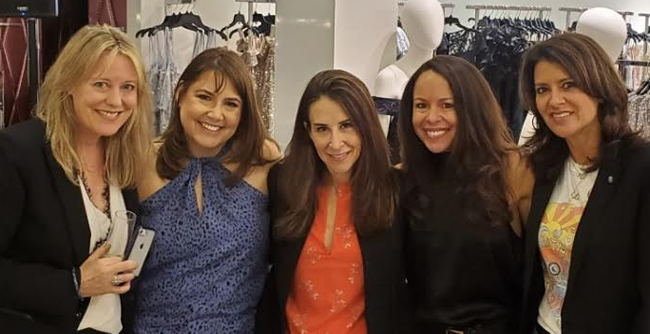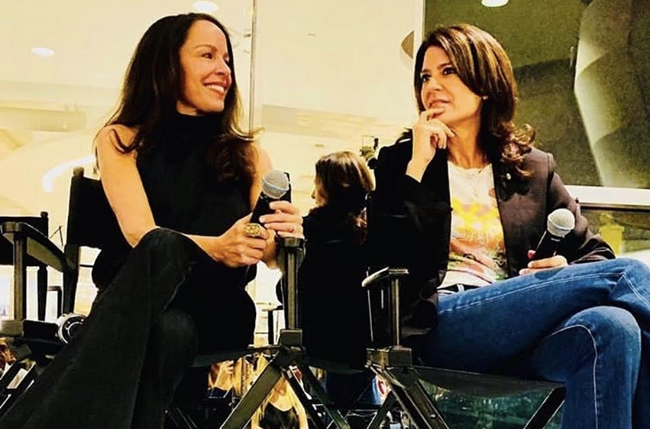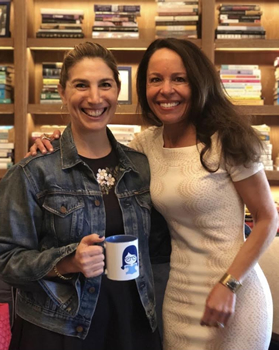

Up Close: Lisa Barr
Déjà Vu All Over Again
 By Josie Brown
By Josie Brown
For internationally renowned bestselling author Lisa Barr, WOMAN ON FIRE is—to paraphrase Yogi Berra—déjà vu all over again: both in the novel’s premise and regarding the author’s personal life and family history.
Like the book’s protagonist, Barr started her professional life as a news reporter. “I was a journalist in the Middle East, so I covered some heavy-duty stuff,” she says. “That training helped me fine-tune the art of suspense; to find the nugget that becomes the story.”
The nugget for this tale came from a true-life incident from a decade ago: an elderly agoraphobic was discovered with a cache of around 1,500 masterworks burrowed in nooks and crannies throughout his apartment. “Matisse, Chagall, Picasso—were literally lying in his stove, in his food pantry,” Barr says.
It turns out that this hoarder was the son of Hitler’s art thief Hildebrand Gurlitt, who was one of four art dealers tasked by the German dictator with confiscating the priceless art collections of Jews. “When I read this, the journalist in me knew it was a story. I could literally feel the prickles climbing up my arms,” Barr says.
WOMAN ON FIRE takes its name from the book’s fictitious stolen painting. And, as with Gurlitt’s theft, the family who ends up owning the work of art is a different Jewish family than the one from which it was stolen.
Barr’s thriller poses the question Did they come into ownership through dubious means?
“I thought, ‘Is it a crime if you steal from a robber?’ And that is where the book starts,” Barr says.
From there, Barr turned her thoughts on everyone else who would have a vested interest in the painting. Thankfully, she’d laid that groundwork years ago. “I researched [the topic of art theft] for four years in my debut novel, Fugitive Colors. It was as if a motor was already behind it.”
The book’s protagonist—the young, gutsy female journalist Jules Roth—is known to do anything to get a story. In fact, even in high school, she uncovered an underage sex ring.
Talk about real life being stranger than fiction: It is an incident out of Barr’s life. “In high school, while interning for a state senator, I was asked to pose as bait to break a sex porn ring. It was scary and exciting—and a very big story at the time.”
The incident is the door buster—almost literally—that Jules uses to impress the editor who is her idol, Chicago newspaper editor Dan Mansfield, a hard-hitting investigative journalist who has seen and done it all himself.
Dan then enlists Jules for a story that will test all her journalistic faculties: research, interviewing, and facing down danger at the hand of the one person who will do anything to hold on to the painting: the book’s antagonist, Margaux de Laurent.
“She’s me before I became crusty and jaded,” Barr says. “Before kids, I would take on any story that broke. Nothing mattered but the truth. I didn’t see it as a life risk. I had tunnel vision for getting the right story, to expose the bad things going on.”
Whereas it would have been easy for Barr to go all-out evil with Margaux, instead she took a deep dive into her psyche. “I wanted to show where she had a lot of pain, a lot of damage, a lot of loneliness in her life—how she was formed into this dark person. She was born with those qualities. At the same time, she was triggered in big ways.”
Despite the kindness of Margaux’s mentor: her dearly departed grandfather. “He was her saving grace. If she was going to be doing any good, it was with him in mind. He was the only who really loved her, nurtured her, and saw her vulnerabilities.”
In fact, Margaux uses his ideal of her as a personal cudgel—to justify her actions.
Barr loved writing her, for so many reasons. “I’ll bet if you surveyed writers, you’d find that most of us love writing our evil characters. It’s fun! You can go dark!”
Just as vulnerable (albeit less nefarious) are Dan and his mentor, billionaire shoe designer Ellis Baum, who has tasked him with finding the long-lost painting. “The restitution of art has been a traumatic experience for heirs of holocaust survivors,” Barr says. “They’ve been locked in years of legal battles. I envisioned Ellis as Ralph Lauren: someone not using his real name, who built a public persona from scratch but came from a much more meager background. He’s part of the American dream. And of course, everyone must wear their Anika Baums at all the award shows. I wanted to create someone in pop culture who people think has everything. But do they?”
But for Ellis, shoes symbolize his mother’s darkest hour. “You can’t erase that. No matter how big or how great you become, you can’t let go of that core part of you. So as he’s approaching his end, he needs to connect to her more than ever.”
When he reads of the found art, Ellis knows that there is a good chance that the painting his mother posed for is among the found master works. “It lights a fire under him. He’s got to get this painting. But is his claim stronger than Margaux’, whose grandfather owned the painting, who has the correct documents? I wanted to create a situation of push and pull. Whose painting is it, at the end of the day?”
As much as this is a globetrotting thriller, it is the layered relationships between the characters that kick it into literary heights.
One of the most touching is between Dan and Ellis, who met under circumstances so vulnerable that it only cemented a bond they share.

Barr (second from right) with her favorite critically acclaimed authors and book influencers (from left to right) Amy Poeppel, Book influencer Lauren Margolin of The Good Book Fairy, Allison Winn Scotch, and Rochelle Weinstein at Bloomingdales in Santa Monica
Par for the course, considering that Barr is a character-driven writer. “I think through everything about the character, down to how they smell, what they like to eat, everything—and then, how they connect. Dan is not a fashionable guy. That’s not his gig. Yet here he is, with the elegant Ells Baum. But what Dan does need is a father figure. I figure out where everyone crosswires and finds something in another character. I plot that out heavily. I know who these characters are. We authors have one foot in the real world and one in our imaginary, observatory world for all these things that we collect. But there is a method to our madness. No one is off limits.”
Another key character, Ellis’ grandson, Adam, also has a traumatic past of which was the nefarious Margaux was the catalyst: addiction to drugs and to sex. Because of his attraction to Jules and him, Margaux’ goal is to make him the bait in her trap for the young, naïve reporter.
Considering Margaux’ similarities to Ghislaine Maxwell—recently on trial for her role in the Jeffrey Epstein porn ring scandal—the release of WOMAN ON FIRE couldn’t be timelier. “Like Margaux, she too grew up with money and power—and the damage that went on there.”
No doubt about it: WOMAN ON FIRE is a woman-to-woman showdown. “Twenty years ago, that would have never happened. Dan would have been in the lead. Jules would have been the young female sidekick. She is not that here.” Barr sees it as a reflection of the world. “Now women are at the head of everything. So why wouldn’t they be helming of our literary stories too?”
Villains are no longer predominantly men either. “Nor should they be,” Barr points out. “Back in the day, you would have had the femme fatale to lure the male protagonist off course in a sexy way. Now a man can be in the supporting role. I loved writing Adam through Jules’ eyes.”
But one character near and dear to her heart is Ellis’ half-sister, Lillian, who has an important role in the painting’s final home.
Barr, who is the granddaughter of a holocaust survivor, explains: “My grandmother’s voice was in my head. She was feisty. My family survived because of her fearlessness for her family. I tried to give some of that to Lillian.”
Even with all the plot twists that keep the pages turning, this thriller’s biggest revelation is the painting’s own story: one that goes far beyond how it relates to the novel’s characters.
“I wasn’t just going to let her sit there, looking pretty,” Barr adds with a chuckle. “She had to have a purpose other than being the artist’s muse. To have somehow survived the holocaust—even as a painting, and when so many amazing ones were burned and destroyed—your history is just as twisted as a person’s. When you can watch the journey of one specific painting, you better understand the bigger picture. This painting represents the 650,000 works of art that were stolen, confiscated—looted. Giant numbers can be too big to comprehend. You realize ‘This really happened.’”
Barr’s mission is why WOMAN ON FIRE may be her greatest masterwork.
- Up Close: Jane Smiley - November 30, 2022
- Up Close: Lisa Barr - February 28, 2022
- Up Close: Kaira Rouda - December 31, 2021




